
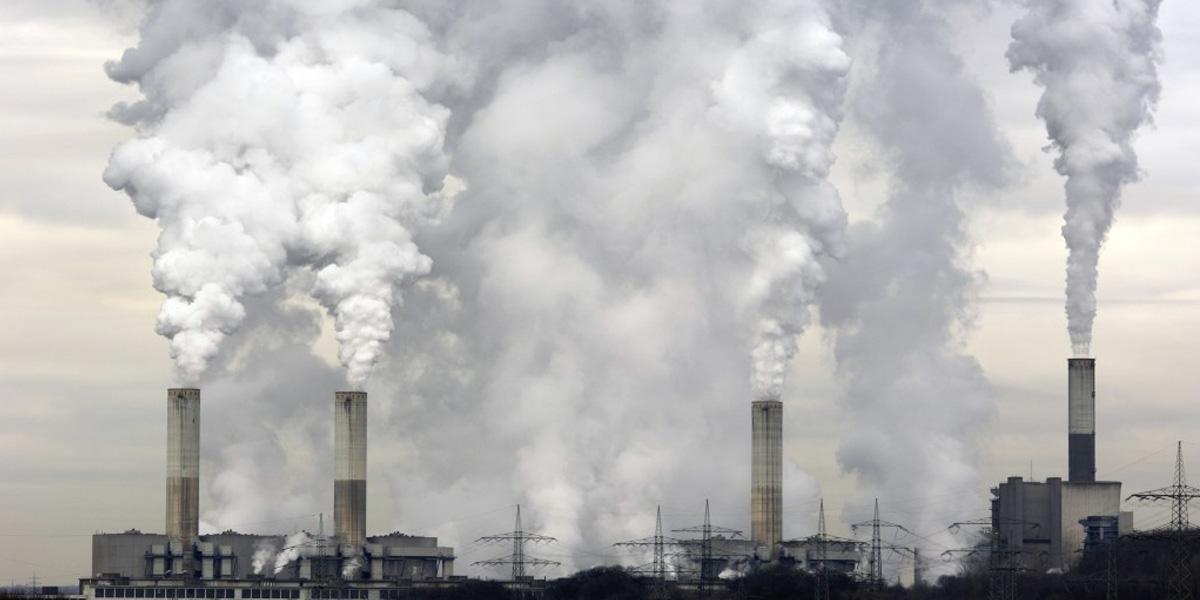
By Jeff Masters
Decades of progress on cleaning up our dirty air took a significant hit on Tuesday, along with hopes for a livable future climate, when President Trump issued his Energy Independence Executive Order. Most seriously, the order attacks the U.S. Environmental Protection Agency’s (EPA) Clean Power Plan, which requires a 32 percent reduction in CO2 emissions from existing power plants by 2030 (compared to 2005 emission rates).
Tuesday’s blow was just the latest in a series of attacks that threaten our health and the planet’s health. On March 15, Trump also ordered the EPA to review tough air pollution rules for cars and light trucks that were set to kick in between 2022 and 2025. Trump’s proposed budget for fiscal year 2018, released earlier this month, slashed funding for the EPA by 31 percent and eliminated money for renewable energy programs and energy efficiency efforts such as the Energy Star program.
Trump’s war on clean air will potentially kill tens of thousands of people annually and have health costs in the 10 of billions of dollars each year. Separate studies done in 2016 by the World Bank and by the Health Effects Institute (a U.S. non-profit corporation funded by the EPA and the auto industry) estimated that air pollution kills between 91,000 and 100,000 Americans each year—nearly double the number of U.S. combat deaths (58,000) in Vietnam or more than 30 times the death toll of the 9/11 terror attacks. The EPA estimated that tough air pollution regulations under the Clean Air Act that began in 1990 saved more than 164,000 lives in the year 2010 alone.
Damages from U.S. air pollution are extreme. The World Bank study estimated that in the year 2013 alone, the U.S. suffered $473 billion in health-related damages from air pollution—about 2.9 percent of the GDP. Health care consumes one-quarter of the $3.7 trillion federal budget and air pollution is a significant contributor to that bill.
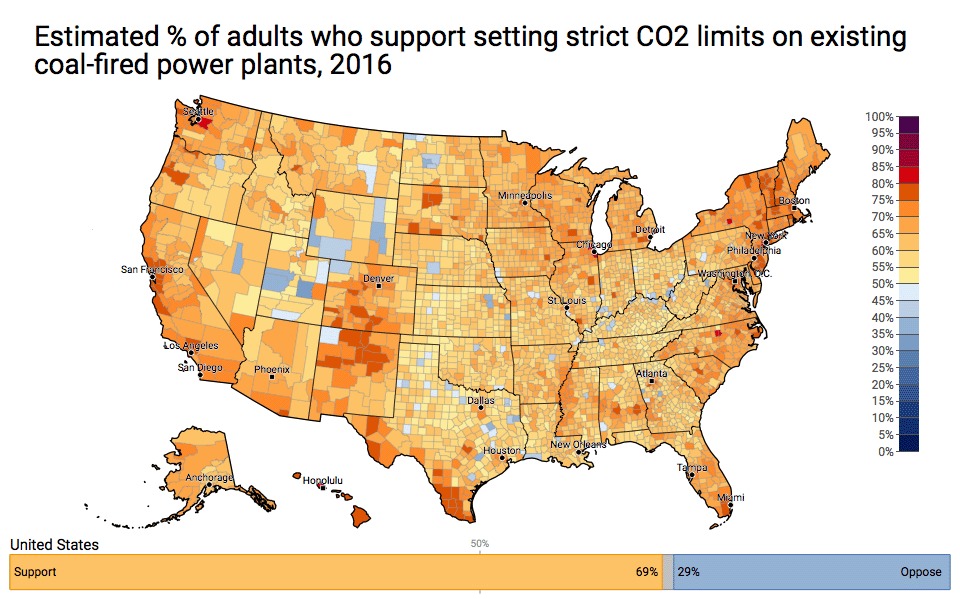
Power plants are the single largest source of greenhouse gas emissions in the U.S.—about 31 percent of the total and are also a significant source of deadly air pollution—about 26 percent of all air pollution deaths in the U.S. according to a 2013 MIT study. The authority for the Clean Power Plan comes from the EPA’s Clean Air Act, along with the Supreme Court’s 2007 decision requiring the EPA to regulate carbon dioxide as a pollutant. The Clean Power Plan is a key component of America’s commitment to reduce global warming under the 2015 Paris climate agreement and there is broad public support for reducing emissions of CO2 from existing coal-fired power plants (69 percent of Americans, including majorities in all 50 states and all 435 Congressional Districts, see Figure 1).
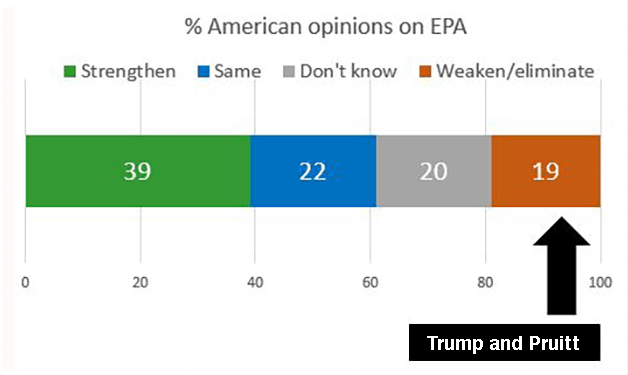
Benefits of the Clean Power Plan Far Exceed the Costs
The EPA estimates that annual costs to industry of the Clean Power Plan will be $1.4 – $2.5 billion in 2020, increasing to $5.1 to $8.4 billion per year in 2030. These estimates factor in the costs of investments in transitioning to lower-carbon electricity options and the savings that result from investments in energy efficiency. Electricity bills are predicted to rise modestly by 2.4 to 2.7 percent in 2020, but then decline by 2.7 to 3.8 percent in 2025 and 7 to 7.7 percent in 2030 as investments in energy efficiency pay off.
The public health and climate benefits of the Clean Power Plan are worth an estimated $34 billion to $54 billion per year in 2030, far outweighing the costs, the EPA estimates. Burning fewer fossil fuels will create less air pollution and air pollution from the power generation industry will fall about 25 percent by 2030 if the Clean Power Plan is adopted. The EPA projects that the reduction in pollution will prevent up to 3,600 deaths, 1,700 heart attacks, 90,000 asthma attacks and 300,000 missed work and school days per year by 2030 (note that a person who dies from air pollution-related causes typically dies about 12 years earlier than they otherwise might have, according to Caiazzo et al., 2013).
For every dollar Americans spend on the Clean Power Plan, four dollars worth of health benefits will result, said the EPA. The greatest benefits would come in the upper Ohio Valley and farther downwind, where pollution from power plants is highest: southeast Ohio, northwest West Virginia and western Pennsylvania—areas Trump carried in the 2016 election, including two swing states that pushed him over the top.
Figure 3. Levels of the deadliest pollutant, fine particles less than 2.5 microns in diameter (PM 2.5), have fallen by 37 percent and prevented tens of thousands of premature deaths since 2000, thanks to EPA Clean Air Act regulations.EPA
Opposition to the Clean Power Plan
As one should expect, lobbying groups who receive money from the fossil fuel industry are unhappy with the Clean Power Plan and criticize the plan’s complexity and large number of regulations. They have a point—it would have been far simpler and more effective to achieve the plan’s goals through a cap-and-trade system or through a cap-and-dividend approach or by having Congress adopt a simple carbon tax of $40 per ton (a version of which was proposed in February by a group of Reagan and Bush-era Republicans called the Climate Leadership Council). However, Congress failed to pass a cap-and-trade bill during Obama’s first term. He was forced to use the regulatory power of the EPA to bring about the reduction in U.S. greenhouse gas emissions needed for the Paris climate agreement.
Critics also dispute EPA’s cost estimates, saying the costs will be much higher. Several of these criticisms state only the costs, not the benefits, and also ignore the huge death toll of air pollution. And at least one study has found that the EPA underestimated the benefits and lives saved by the Clean Power Plan. This was an independent analysis by Energy Innovation: Policy and Technology LLC, an energy and environmental policy firm. In a 2017 study, they estimated that the cumulative savings to the U.S. economy (in reduced capital, fuel and operations and maintenance expenditures) of adopting the Clean Power Plan would exceed $100 billion by 2030 and reach almost $600 billion by 2050, assuming that pollution reductions continue to stay strong after 2030. Failure to adopt the Clean Power Plan would cause more than 40,000 premature deaths annually in 2030 and more than 120,000 per year by 2050. Energy Innovation came up with their estimates using the Energy Policy Simulator open-source computer model.
Figure 4. Costs and benefits of the Clean Power Plan as estimated by the EPA. EPA
Repealing the Clean Power Plan Won’t Happen Quickly
The Clean Power Plan will be difficult to undo quickly. The plan was finalized by EPA in 2015 and is currently being reviewed in the U.S. Court of Appeals for the District of Columbia Circuit. Under the new executive order, the Department of Justice will ask the court to suspend the case until the EPA can review and write a new version of the rule. (Before that happens, the court may still rule on the plan as written, which will influence how the EPA can rewrite the rule).
Once the case is removed from the court, the EPA will have to legally withdraw the existing rule and propose a new rule to take its place, a process that could take years, as the new rule will have to be justified in court and would likely be challenged in court by environmental groups, according to an in-depth analysis by Brad Plumer at Vox. In the meantime, nothing prevents states from continuing to reduce emissions by implementing renewable energy standards, efficiency programs or cap-and-trade programs like exist in California and the Northeast. Thus, some of the benefits of the Clean Power Plan will happen regardless of Trump’s orders and 31 states are on track to be more than halfway toward their near-term Clean Power Plan emission reduction requirements (Figure 5).
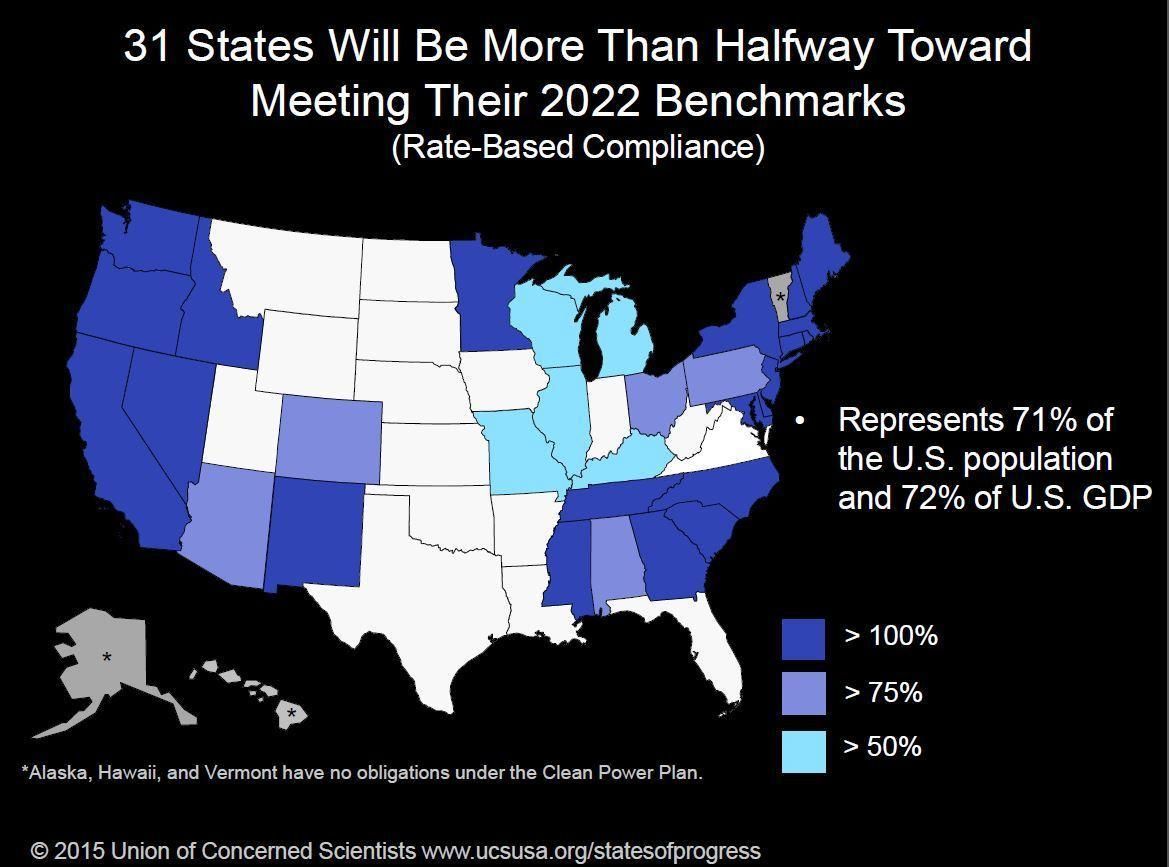
New Executive Order Attacks the “Social Cost of Carbon”
The “social cost of carbon” is an estimate of how much human emissions of carbon dioxide cost society via damage to the climate. In 2015, this number was set at $36 per ton of carbon dioxide pollution and the social cost of carbon underpins at least 150 federal regulations. The “social cost of carbon” tries to answers the question, “how much should we be willing to pay to avert future climate damages?” This number is highly uncertain, but is definitely not zero. Trump’s executive order calls for a reassessment of the social cost of carbon, with the aim of reducing it or entirely circumventing it. Carbon Brief has an excellent explainer on the “social cost of carbon.”
Automobile Fuel Efficiency Standards to Be Reviewed
President Trump, speaking in Detroit this month to a group of autoworkers, said the EPA will take action to potentially relax tough air pollution rules for cars and light trucks that were set to kick in between 2022 and 2025. A review of the rules was completed in 2016, ahead of a 2018 deadline. “It was necessary (to resume the review) because the standards were set far into the future,” Trump said. “If the standards threaten auto jobs, then common sense changes could have—and should have—been made.” The review opens up the possibility that the strict fuel economy regulations for 2022 to 2025 will be significantly weakened; it is relatively easy for the EPA to undo the regulations, according to a New York Times analysis.
Once the 2017 review is finished, the EPA can withdraw the current rule for post-2021 emissions and put forth an alternative set of standards within a year. The EPA may also withdraw a waiver that allows California (and other states that have joined it) to enforce stricter auto emissions standards than the federal government imposes. Air pollution from vehicles in the U.S. is responsible for about 26 percent of all U.S. air pollution deaths, so weakening these regulations will likely result in thousands of premature deaths that would not have occurred otherwise—in addition to the thousands of deaths we can expect from a weakening of the Clean Power Plan.
U.S. Paris Climate Agreement Commitments Unlikely to Be Met
Trump’s executive order and proposed budget make it clear that we can expect most of the efforts to reduce U.S. emissions of greenhouse gases under the Paris climate agreement to come under attack and it is unlikely the U.S. pledge will be met. In that landmark agreement, the U.S. promised a 26 to 28 percent reduction in U.S. greenhouse gas emissions by 2025, as its fair share of the effort to keep global warming no more than 2°C above preindustrial levels (the generally accepted goal for avoiding dangerous impacts).
According to an excellent analysis by Vox, the Clean Power Plan accounts for roughly one quarter of all the emission reductions promised by the U.S. as part of the 2015 Paris climate agreement. The other three-quarters of the reductions were to come primarily from stricter fuel economy stands for vehicles, tighter emission standards for new coal- and gas-fired power plants, new regulations to curtail methane leaks and limit methane from agriculture, energy efficiency measures and initiatives to curtail hydrofluorocarbons (another potent greenhouse gas).
Taken altogether, the numbers from these efforts don’t quite add up to the promised 26 to 28 percent reduction in greenhouse gases by 2025, said a 2015 World Resources Institute analysis—and thus additional actions beyond what Obama proposed would be needed. According to a 2016 paper, Assessment of the climate commitments and additional mitigation policies of the United States and the Climate Action Tracker web site, current U.S. policies, including the Clean Power Plan, would only reduce emissions by nine percent below 2005 levels by 2025. A much more aggressive Clean Power Plan was being counted on, plus a whole host of “TBD” actions needed from President Obama’s successor.
An excellent new analysis by the Rhodium Group predicts that Trump’s current executive orders and proposed budget will most likely result in a 14 percent reduction in U.S. greenhouse gas emissions below 2005 levels by 2025—far below the promised 26 to 28 percent reduction of the Paris climate accord. The Rhodium Group’s worst-case scenario—if further efforts to weaken greenhouse gas regulations occur, such as a rollback of automobile emission standards for the 2022 to 2025 period—was a nine percent reduction in U.S. greenhouse gas emissions by 2025; their best-case scenario was a 17 percent reduction.
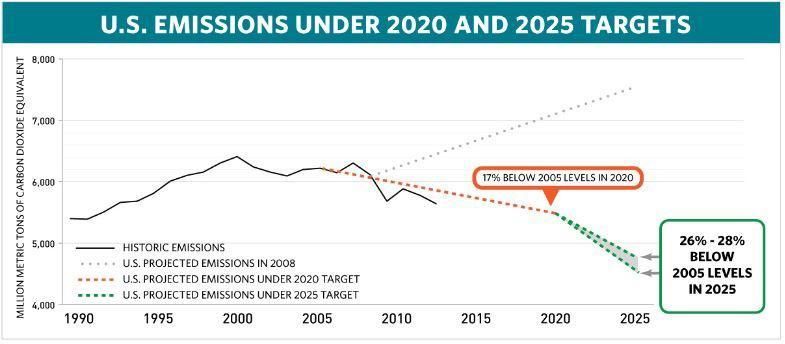
Assault on Methane Emission Rules
Methane is also a major greenhouse gas and Trump’s executive order directs efforts to reconsider and rewrite rules on methane emissions. This follows the March 2 directive from the EPA to withdraw a 2016 Information Collection Request which directed existing oil and gas facilities to provide data needed to best reduce methane and other harmful emissions from the oil and natural gas industry. However, new methane rules will take years to rewrite and will have to suffer court challenges and one state—California—voted on March 23 to approve new methane regulations that are the strictest ever adopted in the U.S.
More Serious Attacks on Clean Air and Clean Water Likely Coming
Wunderground’s climate change blogger, Dr. Ricky Rood, in a 2017 editorial in EOS warned that, “Following Trump’s rhetoric, we must be prepared to face efforts aimed at weakening the Clean Air Act itself. Also in the crosshairs are many other environmental statutes passed in the 1970s, such as the National Environmental Policy Act, the Clean Water Act, the Endangered Species Act and the Safe Drinking Water Act. In terms of enduring impacts, weakening of these underlying statutes will be more consequential than scuttling the Clean Power Plan.”
In an email to me, Dr. Rood said he believes that a rollback of auto emission standards will ultimately end up being more consequential to air pollution and the climate than a rollback of the Clean Power Plan. This will be because market forces are making it likely that the power generation industry will head towards renewable energy sources, but market forces are not acting that way on the auto industry—external regulation is needed to force emission reductions.
Links
The latest assault on climate science by House Republicans happens on March 29, when the House Committee on Science, Space and Technology holds a two-hour hearing titled Climate Science: Assumptions, Policy Implications and the Scientific Method. The Republicans have called three witnesses: Dr. Judith Curry, Dr. John Christy and Dr. Roger Pielke, Jr., all of whom are unfriendly to climate science. The Democrats got to call one witness, Dr. Michael Mann of climate “hockeystick” fame. The hearing is being live streamed here. The Democratic press team will be using the hashtags #defendscience and #ActonClimate during the hearing.
Brad Plumer of Vox has an excellent explainer on Trump’s executive order.
Follow the Climate Deregulation Tracker website to monitor efforts undertaken by the Trump administration to scale back or wholly eliminate federal climate mitigation and adaptation measures.
March Madness: Trump Proposes 31% Cut to EPA and Big Cuts to Climate Change Programs, my March 16 post.
EPA Chief Denies Basic Climate Science, my March 10 post.
Commentary
“Together we are going to start a new energy revolution,” Trump said, upon signing Tuesday’s executive order. However, his order promotes dirty and deadly 19th century coal technology, instead of clean 21st century renewable energy solutions like wind and solar power, making his remarks sadly preposterous. The name of his order, the Energy Independence Executive Order, is also preposterous, since the U.S. doesn’t import coal and the stated primary aim of the new order is to revive the coal industry (coal miners were on hand for the signing ceremony).
In his first speech to Congress, Trump promised that his administration would work to “promote clean air and clean water.” This promise has been exposed as a blatant falsehood by his executive orders and proposed budget, which move us sharply in the opposite direction. By itself, a U.S. failure to make its emission reduction targets of the Paris climate agreement will not doom the world to a dangerous rise in temperature above the 2°C threshold. However, we’ll be lucky to hold global warming to an extremely dangerous 3°C above pre-industrial levels, even if all of the promises made by the 195 nations that signed the Paris agreement are met. That agreement counted on strong additional actions and leadership by the biggest emitting nations to force additional cuts in greenhouse gas emissions.
Lack of inspirational American leadership, as glaringly evident in Mr. Trump’s latest executive order, will hurt global efforts to meet even the grossly inadequate goal of keeping global warming below 3°C, increasing the odds that humanity will have to resort to desperate geoengineering efforts to keep climate mayhem from wrecking Earth as a livable planet for humans. We must resist and protest Trump’s assault on clean air and a livable climate as if our lives depend upon it—because they do.
Contact your House Representative
Reposted with permission from our media associate Weather Underground.

 233k
233k  41k
41k  Subscribe
Subscribe 